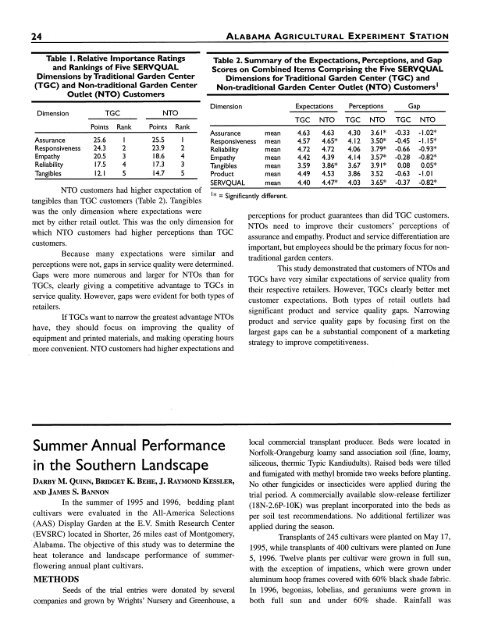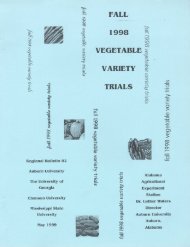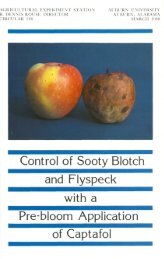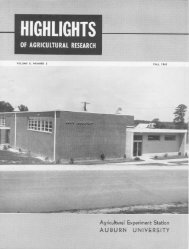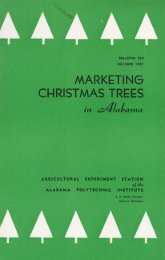1997 Ornamentals Research Report - AUrora - Auburn University
1997 Ornamentals Research Report - AUrora - Auburn University
1997 Ornamentals Research Report - AUrora - Auburn University
Create successful ePaper yourself
Turn your PDF publications into a flip-book with our unique Google optimized e-Paper software.
24<br />
24<br />
Table I. Relative Importance Ratings<br />
and Rankings of Five SERVQUAL<br />
Dimensions by Traditional Garden Center<br />
(TGC) and Non-traditional Garden Center<br />
Outlet (NTO) Customers<br />
Dimension TGC NTO<br />
Points Rank Points Rank<br />
Assurance 25.6 I 25.5 I<br />
Responsiveness 24.3 2 23.9 2<br />
Empathy 20.5 3 18.6 4<br />
Reliability 17.5 4 17.3 3<br />
Tangibles 12.1I 5 14.7 5<br />
NTO customers had higher expectation of<br />
tangibles than TGC customers (Table 2). Tangibles<br />
was the only dimension where expectations were<br />
met by either retail outlet. This was the only dimension for<br />
which NTO customers had higher perceptions than TGC<br />
customers.<br />
Because many expectations were similar and<br />
perceptions were not, gaps in service quality were determined.<br />
Gaps were more numerous and larger for NTOs than for<br />
TGCs, clearly giving a competitive advantage to TGCs in<br />
service quality. However, gaps were evident for both types of<br />
retailers.<br />
If TGCs want to narrow the greatest advantage NTOs<br />
have, they should focus on improving the quality of<br />
equipment and printed materials, and making operating hours<br />
more convenient. NTO customers had higher expectations and<br />
m~~ 1 1 . . 1 m/l/T( J<br />
Summer Annual Performance<br />
in the Southern Landscape<br />
DARBY M. QUINN, BRIDGET K. BEHE, J. RAYMOND KESSLER,<br />
AND JAMES S. BANNON<br />
In the summer of 1995 and 1996, bedding plant<br />
cultivars were evaluated in the All-America Selections<br />
(AAS) Display Garden at the E.V. Smith <strong>Research</strong> Center<br />
(EVSRC) located in Shorter, 26 miles east of Montgomery,<br />
Alabama. The objective of this study was to determine the<br />
heat tolerance and landscape performance of summerflowering<br />
annual plant cultivars.<br />
METHODS<br />
Seeds of the trial entries were donated by several<br />
companies and grown by Wrights' Nursery and Greenhouse, a<br />
ALABAMAAGRICULTURAL EXPERIMENT STATION<br />
ALABAMA AGRICULTURAL EXPERIMENT STATION<br />
Table 2. Summary of the Expectations, Perceptions, and Gap<br />
Scores on Combined Items Comprising the Five SERVQUAL<br />
Dimensions for Traditional Garden Center (TGC) and<br />
Non-traditional Garden Center Outlet (NTO) Customers<br />
Dimension Expectations Perceptions Gap<br />
TGC NTO TGC NTO TGC NTO<br />
Assurance mean 4.63 4.63 4.30 3.61 * -0.33 -I.02*<br />
Responsiveness mean 4.57 4.65* 4.12 3.50* -0.45 -1.15*<br />
Reliability mean 4.72 4.72 4.06 3.79* -0.66 -0.93*<br />
Empathy mean 4.42 4.39 4.14 3.57* -0.28 -0.82*<br />
Tangibles mean 3.59 3.86* 3.67 3.91* 0.08 0.05*<br />
Product mean 4.49 4.53 3.86 3.52 -0.63 -1.01<br />
SERVQUAL mean 4.40 4.47* 4.03 3.65* -0.37 -0.82*<br />
1* = Significantly different.<br />
perceptions for product guarantees than did TGC customers.<br />
NTOs need to improve their customers' perceptions of<br />
assurance and empathy. Product and service differentiation are<br />
important, but employees should be the primary focus for nontraditional<br />
garden centers.<br />
This study demonstrated that customers of NTOs and<br />
TGCs have very similar expectations of service quality from<br />
their respective retailers. However, TGCs clearly better met<br />
customer expectations. Both types of retail outlets had<br />
significant product and service quality gaps. Narrowing<br />
product and service quality gaps by focusing first on the<br />
largest gaps can be a substantial component of a marketing<br />
strategy to improve competitiveness.<br />
local commercial transplant producer. Beds were located in<br />
Norfolk-Orangeburg loamy sand association soil (fine, loamy,<br />
siliceous, thermic Typic Kandiudults). Raised beds were tilled<br />
and fumigated with methyl bromide two weeks before planting.<br />
No other fungicides or insecticides were applied during the<br />
trial period. A commercially available slow-release fertilizer<br />
(18N-2.6P-10K) was preplant incorporated into the beds as<br />
per soil test recommendations. No additional fertilizer was<br />
applied during the season.<br />
Transplants of 245 cultivars were planted on May 17,<br />
1995, while transplants of 400 cultivars were planted on June<br />
5, 1996. Twelve plants per cultivar were grown in full sun,<br />
with the exception of impatiens, which were grown under<br />
aluminum hoop frames covered with 60% black shade fabric.<br />
In 1996, begonias, lobelias, and geraniums were grown in<br />
both full sun and under 60% shade. Rainfall was


